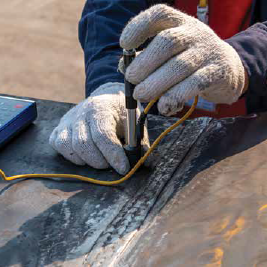COURSE INFORMATION
Ultrasonic Testing (UT) is a powerful non-destructive testing (NDT) method that relies on the mechanical vibration of sound waves in the ultrasonic range (frequencies greater than 20 kHz) to uncover volumetric discontinuities within solid materials. In UT, both compression and shear waves play a pivotal role in investigating the internal nature of components. The interaction of these waves with linear, planar, or volumetric anomalies, often referred to as ‘vacancies,’ enables
the characterization of any detected discontinuities.
The primary inspection medium in UT is the sound beam, and a profound understanding of its qualification (properties) and quantification (calibration) is crucial for accurately interpreting signal responses. If you’re someone who enjoys playing pool, possesses a penchant for geometry and trigonometry, and relishes the challenge of deciphering complex structures, then embarking on an Ultrasonic Testing course is a transformative experience. It will revolutionise the way you perceive engineering materials and weldments, offering you a unique perspective into their internal composition.
Within UT, compression and shear waves applications having various angles and frequencies serve as the foundation for determining the techniques used. Additionally, the send-or-receive/send-and-receive capabilities of the sensors, along with scanning methodologies such as the tandem technique, are vital technique parameters. Mastering these parameters empowers you to not only detect defects but also to assess their size, orientation, and position accurately.
Delving into Ultrasonic Testing opens doors to a fascinating world where science, mathematics, and technology converge to ensure the safety and reliability of critical components in various industries. It’s a
discipline that empowers you to become a vital guardian of structural integrity, making it a rewarding and intellectually stimulating choice for those passionate about NDT.
The training course is based on general theory as well as sector specific applications relating, but not limited to, the following standards and specifications:
- ASME Boiler & Pressure Vessel Code – Section V – Subsection A – Article 1, 4 & 5
- ASME Boiler & Pressure Vessel Code – Section V – Subsection B – Article 23
- ISO 16810 UT – General Principles
- ISO 11666 UT – Acceptance Levels
- ISO 17640 UT – Techniques, Testing levels and assessment
- ISO 23279 UT – Characterisation of discontinuities in welds
- ISO 5577 UT – Vocabulary
- ISO 18175 UT – Performance characteristics (no electronic instruments)
- ISO 16827 UT – Characterisation and sizing of discontinuities
- ISO 16826 UT – Discontinuities perpendicular to the surface
- ISO 16811 UT – Sensitivity and range
- ISO 12710 UT – Evaluating electronic characteristics of UT instruments
- ISO 10375 UT – Characterisation of search unit and sound field
- ISO 7963 UT – Calibration block No 2
- ISO 4992 Parts 1 & 2 UT – Steel castings
- ISO 2400 UT – Calibration block No 1
- ISO 22232 Parts 1/3 UT – Equipment characterisation
Details of specific codes utilised in the limited (UT 1.WT) as well as derived or advanced techniques courses (UT 2.7; 2.8; 2.9; 2.10 and 2.11) can be found in the relevant training documents.
Dates
ULTRASONIC TESTING - SAIW CERTIFICATION NDT SCHEME (ISO 9712) | NON-DESTRUCTIVE TESTING - VOLUMETRIC METHODS NDT Method
and Level Industrial
Sector Product Sector
Category Duration
1 day
=8 hours Course
Code UT1 WT
JHB 01 UT1 WT
JHB 02 UT1 WT
JHB 03 UT1 WT
JHB 04 UT1
WT JHB 05 LIMITED
Ultrasonic
Testing
Level 1
Limited
– Wall Thickness Pre-
and
in-service Limited to
wall thickness
measurement
using
compression
probe only Training
4 days Training 27 Jan - 30 Jan 31 Mar - 03 Apr 21 - 24 Jul 08 - 11 Sep 03 - 06 Nov Exam
1 day Exam 31 Jan 04 Apr 25 Jul 12 Sep 07 Nov NDT Method
and Level Industrial
Sector Product Sector
Category Duration
1 day
=8 hours Course
Code UT 1 A
JHB 01 UT 1 A
JHB 02 Ultrasonic
Testing
Level 1 Pre-
and
in-service UT 1.1 Wrought
Product/Forgings
UT 1.2 Castings
UT 1.3 Butt Welds
in Plate
UT 1.4 Butt Welds
in Pipe Training
12 days Training 24 Feb - 11 Mar 25 Aug - 09 Sep Exam
3 days Exam 12 - 14 Mar 10 - 12 Sep NDT Method
and Level Industrial
Sector Product Sector
Category Duration
1 day
=8 hours Course
Code UT 2 A
JHB 01 Ultrasonic
Testing
Level 2 Pre-
and
in-service UT 2.1 Wrought
Product/Forgings
UT 2.2 Castings
UT 2.3 Butt Welds
in Plate
UT 2.4 Butt Welds
in Pipe
UT 2.5 T-joints
& other configurations
UT 2.6 Nozzles Training
12 Days Training 12 - 27 May Exam
3 days Exam 28 - 30 May NDT Method
and Level Industrial
Sector Product Sector
Category Duration
1 day
=8 hours Course
Code ADVANCED Pre-
and
in-service UT 2.10
Ultrasonic
Phased
Array Training
12 days Training Details to follow our website for updates relating to advanced / derived techniques PLEASE NOTE: ADVANCED OPTIONS UT 2.8 - CRITICAL FLAW SIZING: UT 2.9 - AUSTENITIC STAINLESS STEEL AND UT 2.11 - TIME OF FLIGHT DIFFRACTION ARE AVAILABLE ON REQUEST AND SUBJECT TO DEMAND. [1] UT 2 A CERTIFICATION IS REQUIRED AS PREREQUISITE
Costs
| Prices (inclusive of VAT) | |||
| NDT Method and Level | Training & Initial Examination Non-Corporate Members | Training & Initial Examination Corporate Members | Initial Certification |
| LIMITED Ultrasonic Testing Level 1 Limited – Wall Thickness | R16,100 | R15,000 | R2,500 |
| Ultrasonic Testing Level 1 | R38,400 | R35,500 | R2,500 |
| Ultrasonic Testing Level 2 | R38,400 | R35,500 | R2,500 |
| ADVANCED | R41,700 | R38,600 | R2,500 |
Email : ndt@saiw.co.za
Download Ultrasonic Testing (UT) Details Download NDT Course Application Form



